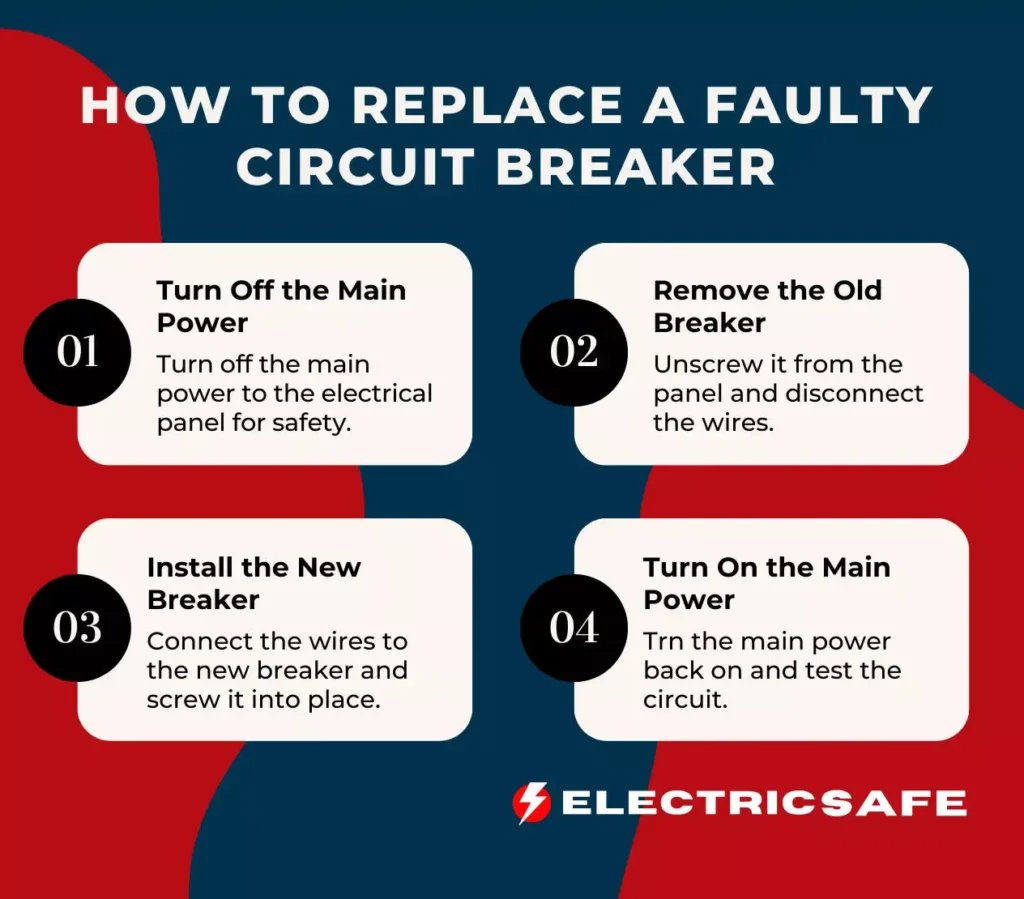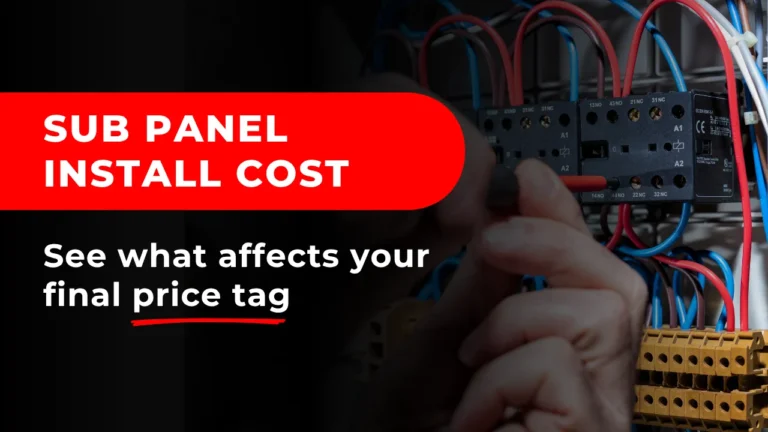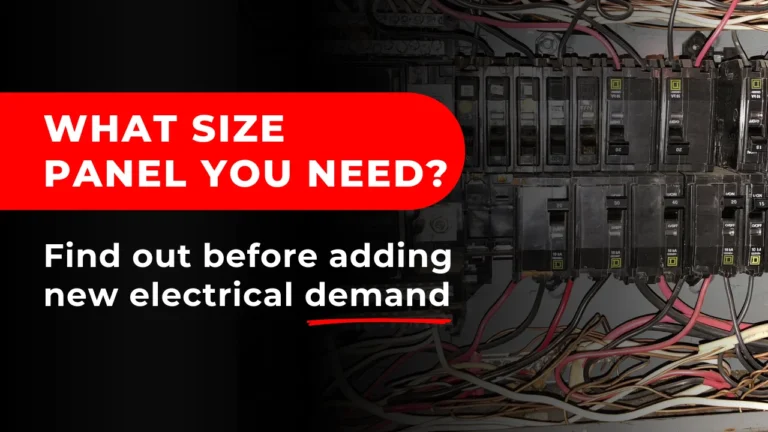You’re in the middle of cooking dinner when the kitchen lights suddenly flicker, and the power goes out. Frustrated, you head to the electrical panel, only to find that the circuit breaker has tripped. You reset it, but as soon as you turn the oven back on, the breaker trips again. Unless you can fix it, UberEats is on the menu tonight.
This scenario is all too familiar to many homeowners. A circuit breaker that keeps tripping can be frustrating and inconvenient, but understanding how to fix a circuit breaker that keeps tripping can save you time and money. In this guide, we’ll outline the steps you should take to identify and fix a circuit breaker that keeps tripping, including calling a licensed electrician when appropriate.
Why Are Your Circuit Breakers Tripping?

If your breaker keeps tripping, how do you pinpoint the issue when there are a lot of potential causes? Here are a few ways to narrow down the possibilities.
Check for Overload
As we have already seen, a circuit consists of a breaker, wiring, and the electric appliances that need to be powered. When you turn on an appliance, it adds to the total load on the electrical circuit. Should you try to use more electricity than the circuit was designed for, an overload may result. When this occurs, the breaker trips, cutting off the power supply to that circuit.
Before resetting the breaker, unplug all appliances on the circuit to help identify the problem. Once the breaker has been reset and has rested for a while, plug in appliances one at a time to see what caused the overloaded circuit. If these circuit overloads occur regularly, you may need to add a new circuit and outlet for that particular region of the home to manage the high amperage load.
Check for a Short Circuit
A short circuit typically happens when a hot (live) wire comes into contact with a neutral wire, causing a sudden surge of current through the circuit. This surge can result in overheating, damage to electrical components, and even fires if not properly managed by protective devices like circuit breakers.
Several factors could contribute to a short circuit, including a faulty electrical switch or receptacle, a damaged fixture or electrical equipment, and faulty cords or plugs. Locating the short circuit isn’t often easy, so call a licensed electrician to handle these situations safely.
Check for a Ground Fault
When hot or live wires come into contact with ground wires, a grounded area of an appliance, or a grounded junction box component, a ground fault occurs, and a vast amount of current flows through the breaker, causing it to trip. These faults can be dangerous because live electrical parts may no longer be protected from unintentional contact, so consult a licensed electrician for any ground fault issues.
Fixing the Circuit Breaker
Once you’ve identified the cause, follow these steps to fix the problem.
Fixing an Overloaded Circuit
- Distribute the Load: If the circuit is overloaded, try redistributing the devices to other circuits. Avoid using too many high-wattage appliances on the same circuit.
- Upgrade the Circuit: If redistributing doesn’t solve the problem, you may need to upgrade the circuit to handle a higher load. This fix requires professional help from an electrician and may require an electrical panel upgrade.
Fixing a Short Circuit or Ground Fault
- Check for a Short in a Specific Appliance: Shorts and ground faults can occur within an appliance or other electrical device when a hot wire touches the housing. Note the last thing you plugged in when the breaker tripped while checking for an overload. If you plug that appliance or device into another circuit and that circuit trips as well, unplug the device immediately and don’t use it until it’s replaced or serviced.
- Inspect for Damage: Look for damaged or frayed wires, loose connections, or exposed wiring. Replace any damaged wires and ensure all connections are secure.
- Use a Multimeter: Test the circuit with a multimeter to check for continuity and identify the location of the short circuit or ground fault.
- Call an Electrician for Shorts and Ground Faults in the Wiring: If the breaker trips immediately upon resetting, even with nothing plugged in or turned on, something in your home’s wiring is likely causing the problem. If you have electrical experience and can determine which device is causing the short, replace the device or correct the loose wire. If you’re not experienced, or you smell something burning or see scorch marks on your walls, call a professional licensed electrician.
Fixing Faulty Appliances
- Test the Appliance: If an appliance is causing the breaker to trip, test it by plugging it into a different circuit. If it trips the breaker again, the appliance is likely faulty.
- Repair or Replace: Depending on the appliance, you may need to repair or replace it. Contact a professional if you’re unsure how to proceed.
Replacing a Faulty Circuit Breaker

- Turn Off the Main Power: Before replacing the breaker, turn off the main power to the electrical panel to ensure safety.
- Remove the Old Breaker: Carefully remove the faulty breaker by unscrewing it from the panel and disconnecting the wires.
- Install the New Breaker: Connect the wires to the new breaker and screw it into place. Ensure it’s securely installed.
- Turn On the Main Power: Once the new breaker is installed, turn the main power back on and test the circuit.
Working with electrical systems can be dangerous. Here are some safety precautions to keep in mind:
- Always Turn Off Power: Before working on any electrical circuit, make sure the power is turned off at the panel.
- Use Insulated Tools: Use tools with insulated handles to reduce the risk of electrical shock.
- Wear Protective Gear: Wear safety glasses and gloves to protect yourself from potential hazards.
- Don’t Overload Circuits: Be mindful of the load on each circuit to prevent overheating and potential fires.
- Know When to Call a Professional: If you’re unsure about any part of the process, don’t hesitate to call a licensed electrician. Safety should always come first.
Preventing Future Issues

To prevent your circuit breaker from tripping in the future, follow these tips:
- Regular Maintenance: Inspect your electrical panel and circuits regularly for signs of wear or damage.
- Avoid Overloading: Be mindful of the number of devices you plug into each circuit. Spread high-wattage appliances across multiple circuits.
- Use Surge Protectors: Protect your appliances and circuits from power surges by using surge protectors.
- Upgrade Old Wiring: If your home has old or outdated wiring, consider upgrading to meet modern safety standards.
- Label Your Circuits: Clearly label each circuit in your electrical panel to make it easier to identify and manage loads.
Why You Need a Professional Electrician
Electrical work can be incredibly complicated and hazardous. You need a detailed understanding of electrical systems, safety protocols, and proper repair techniques before attempting some of the fixes in this article, which is why you’re usually better off calling a pro for a residential electrical inspection.
Professional electricians undergo extensive training and certification to understand various types of electrical systems. They are well-versed in the Ontario Electrical Safety Code and local regulations, ensuring that all work complies with safety standards. Their expertise allows them to diagnose and fix problems efficiently, which can be challenging for someone without a background in electrical work.
A professional electrician can also identify potential problems that may not be immediately apparent to an untrained eye. They can confirm that all repairs are done correctly and spot issues that might cause problems in the future, such as outdated wiring, overloaded circuits, or improper installations. By addressing these issues proactively, a professional can help prevent future electrical failures and the need to call an emergency electrician.
Does Your Circuit Breaker Need Fixing or Replacement?
A circuit breaker that keeps tripping can be a sign of various issues, from overloaded circuits to faulty wiring or appliances. By following the steps outlined in this guide, you can identify the root cause more easily and better address how to fix a circuit breaker that keeps tripping. Always prioritize safety when working with electrical systems, and don’t hesitate to seek professional help if needed.
If you encounter any electrical issues in your home or need help fixing a circuit breaker that keeps tripping, contact Electricsafe in Hamilton, ON. Our team of licensed electricians has the expertise and experience to diagnose and fix electrical problems safely and efficiently. To get your free estimate, contact us. See for yourself why so many Hamiltonians have been trusting us for years.




